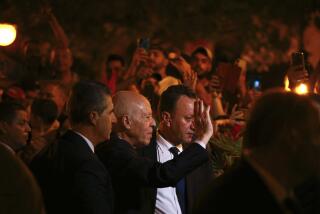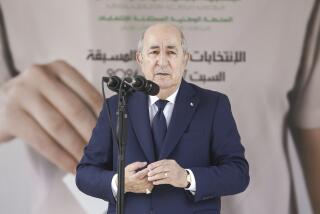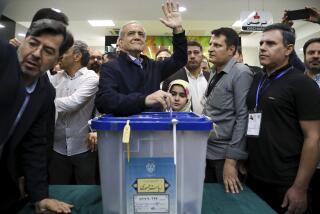Pakistanis Ignore Call for Boycott of Election
- Share via
ISLAMABAD, Pakistan — Pakistanis voted in large numbers Monday, ignoring a boycott called by opponents of President Zia ul-Haq, in Pakistan’s first election in more than seven years.
Government projections and independent press analyses indicated that the overall turnout in the non-party parliamentary election will exceed 40% of Pakistan’s 35 million registered voters. Such a turnout would be roughly equivalent to those in the last two elections, in 1970 and 1977.
The relatively high turnout appeared to constitute a popular victory for Gen. Zia, Pakistan’s military ruler, and a defeat for the Movement for Restoration of Democracy, the coalition of 11 opposition parties that called for the boycott.
Referendum Fizzled
Zia called Monday’s elections after a Dec. 19 referendum to extend his martial-law presidency for another five years failed to attract many voters. He said recently that a turnout of more than 40% Monday would be a success, in effect an endorsement of his regime.
“This election was not a washout like the referendum,” said Mushahid Hussain Sayed, editor of The Muslim, an independent newspaper in Islamabad. “I think he (Zia) pulled it off this time.”
How much of a victory the vote was for Zia--who came to power in a military coup in July, 1977--will depend on analysis of still-incomplete results in the 207 National Assembly contests. Eleven members of Zia’s Cabinet, for example, were up for election Monday, and eight of them faced serious competition.
In its early editions, the major Muslim newspaper in Islamabad reported that five of the Cabinet members were trailing and would probably lose. They included Defense Minister Ali Ahmed Talpur.
In addition, 85 members of the Majlis-e-Shoora (Federal Council), which acts as an advisory body to the Zia government, were in the running, as were 53 members of the Jamiat-e-Islami political party that supports the Zia government.
How well these candidates fared against competition, political observers here say, will be the best test of popular support for Zia.
Some time ago, Zia banned political parties in the campaign and jailed many of the country’s most prominent party politicians, so very few national issues were raised in the campaign.
As a result, the enthusiasm for the election was generated on the local level and involved local issues. “It was a local election on a national scale,” Sayed said.
Voter turnout varied greatly from one political constituency to another. In the central Lahore district of industrialist Nawaz Sharif, who used a fleet of buses and jeeps to get voters to the polls, it was very high. In middle-class areas of Karachi in Sind province, intellectual center for the opposition movement against Zia, it was low.
In general, the turnout was highest in rural areas. “In big cities, people take less interest,” explained Nasim Ahmad Khan, chairman of the town committee in the Punjab province town of Kahna Nau. “But in the small towns people are more religious and happy with President Zia.”
There were several episodes of violence connected with Monday’s voting. Two men were killed in an election conflict at Sahiwal, in southern Punjab. Several buses were damaged at an opposition rally in Lahore that resulted in 27 arrests.
More to Read
Sign up for Essential California
The most important California stories and recommendations in your inbox every morning.
You may occasionally receive promotional content from the Los Angeles Times.










